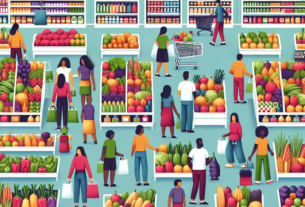Introduction
The global grocery retail industry is undergoing significant changes as we head into 2025. With the rise of e-commerce, changing consumer preferences, and technological advancements, supermarkets are facing both challenges and opportunities in the coming years. In this report, we will analyze the current trends shaping the future of supermarkets worldwide.
Current State of the Global Grocery Retail Industry
According to a recent report by CulinaryCoverage.com, the global grocery retail market is expected to reach a value of $12.24 trillion by 2025. This growth is driven by the increasing population, rising disposable incomes, and urbanization trends in emerging markets. The top players in the industry include Walmart, Costco, Tesco, and Carrefour, which collectively hold a significant market share.
Market Share
Walmart, the world’s largest retailer, dominates the grocery retail market with a market share of over 10%. Costco follows closely behind with a market share of 5%, while Tesco and Carrefour each hold around 3% of the market share. These players are constantly innovating to stay ahead of the competition and meet the evolving needs of consumers.
Financial Performance
In terms of financial performance, Walmart reported revenue of $550 billion in 2024, making it the top player in the industry. Costco generated revenue of $160 billion, while Tesco and Carrefour reported revenues of $90 billion and $80 billion, respectively. These companies are investing heavily in digital transformation and omnichannel strategies to drive growth in the coming years.
Key Trends Shaping the Future of Supermarkets
Several key trends are expected to shape the future of supermarkets in 2025 and beyond. These include:
1. E-Commerce and Digital Transformation
The e-commerce boom has transformed the grocery retail industry, with more consumers shopping online for their groceries. Supermarkets are investing in digital transformation initiatives to enhance the online shopping experience, improve logistics, and offer personalized recommendations to customers. Companies like Walmart and Amazon are leading the way in e-commerce innovation.
2. Sustainability and Ethical Sourcing
Consumers are increasingly concerned about sustainability and ethical sourcing practices in the food industry. Supermarkets are responding by sourcing products from sustainable suppliers, reducing food waste, and promoting environmentally friendly packaging. Companies that prioritize sustainability are likely to gain a competitive edge in the market.
3. Health and Wellness
The demand for healthy and organic products is on the rise, leading supermarkets to expand their offerings in this category. Consumers are seeking fresh, nutritious foods and are willing to pay a premium for high-quality products. Supermarkets that cater to the health-conscious consumer are well-positioned for growth in the future.
Challenges Facing Supermarkets
Despite the opportunities in the grocery retail industry, supermarkets are facing several challenges that could impact their future growth. These challenges include:
1. Competition from Online Retailers
Online retailers like Amazon are disrupting the traditional grocery retail model, posing a threat to brick-and-mortar supermarkets. Supermarkets must adapt to the changing landscape by investing in e-commerce capabilities, offering click-and-collect services, and improving their online presence to compete effectively.
2. Labor Shortages and Rising Costs
Supermarkets are facing labor shortages and rising costs due to inflation, supply chain disruptions, and increased competition for skilled workers. To address these challenges, supermarkets are investing in automation, robotics, and AI to streamline operations, reduce costs, and improve efficiency.
3. Changing Consumer Preferences
Consumer preferences are constantly evolving, with shoppers seeking convenience, value, and personalized experiences. Supermarkets must adapt to these changing preferences by offering innovative products, enhancing the shopping experience, and creating loyalty programs to retain customers.
Future Outlook and Opportunities
Despite the challenges facing supermarkets, there are significant opportunities for growth in the coming years. By focusing on e-commerce, sustainability, health and wellness, and innovation, supermarkets can position themselves for success in the evolving grocery retail landscape. Companies that embrace digital transformation, prioritize sustainability, and cater to the health-conscious consumer are likely to thrive in the competitive market.
Conclusion
In conclusion, the global grocery retail industry is undergoing significant changes in 2025, driven by e-commerce, changing consumer preferences, and technological advancements. Supermarkets must adapt to these trends by investing in digital transformation, sustainability, and health and wellness to stay competitive in the market. By addressing the challenges and seizing the opportunities ahead, supermarkets can shape a successful future in the evolving grocery retail landscape.



